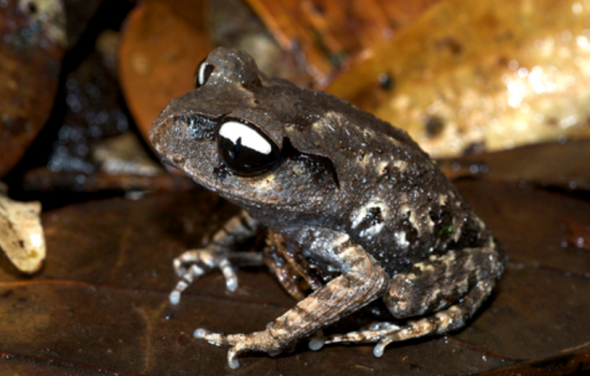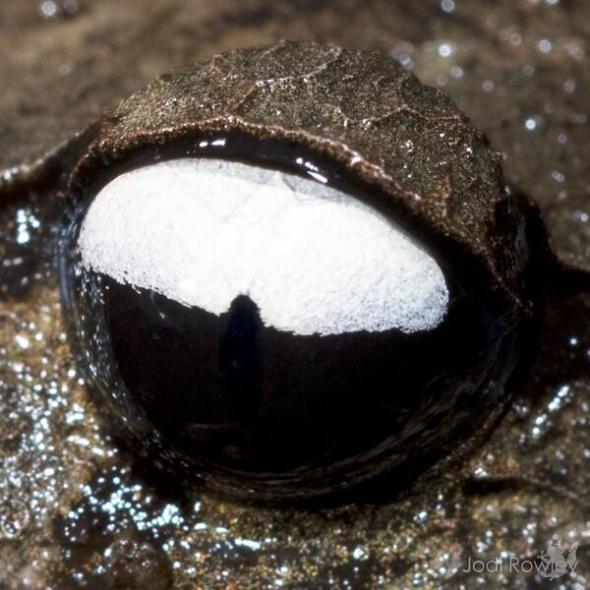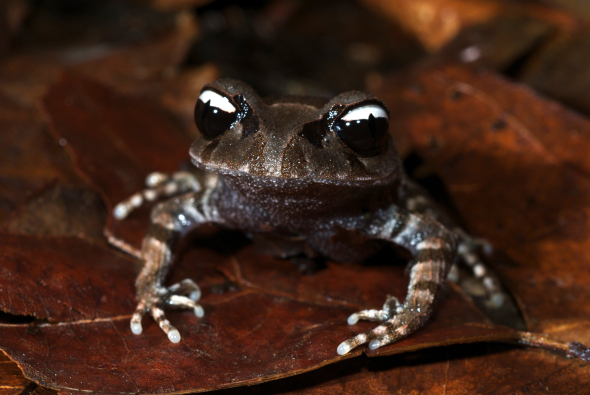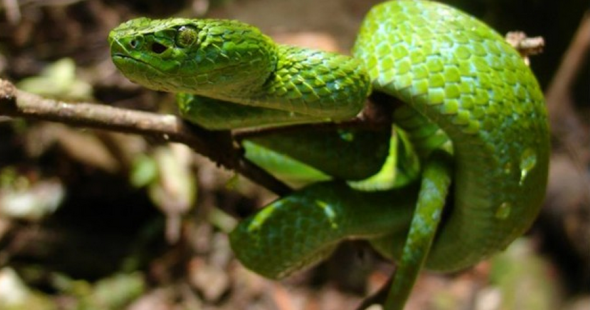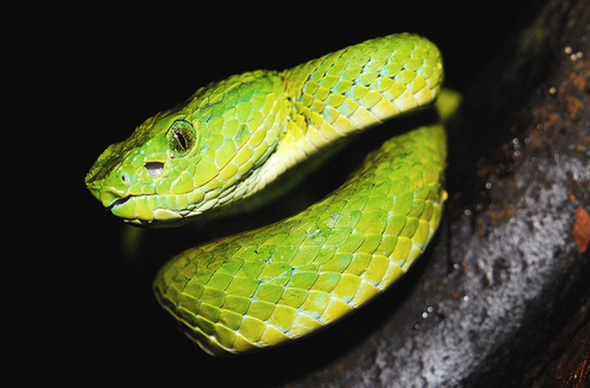Endangered Species Monday: Leptobrachium leucops | Yin and Yang
Endangered Species Monday: Leptobrachium leucops
This Monday’s (E.S.P) Endangered Species watch Post I document on this utterly stunning species of Asiatic toad, which some people believe is possibly a frog. Before reading any further, please check out this toads amazing eyes, stunning don’t you think? The species was “allegedly identified back in 2011” by an environmentalist identified only as Dr Stuart Rowley. Welcome to the Yin and Yang Frog.
Evidence tracking shows that a “Dr John Stuart Rowley, 1907-1968 whom I believe was an ornithologist from the United States, may have been the primary ‘herpetologist that located and documented on the species above’, however I believe that I am still slightly wrong on this and that Dr Jodi Rowley can shed more information on this amazing reptilian. Image credit: Mme Dr Jodi Rowley.
Listed as vulnerable due to the species living within a small habitat estimated to be 7,617 km2, the L. leucops is endemic to Viet Nam, South East Asia, furthermore there are no records that prove the species is used within the Asiatic medicine trade known as (TCM), Traditional Chinese Medicine. Populations are now known to be decreasing primarily due to the illegal and unregulated trade of timber, which is growing rapidly out of control within Viet Nam, Thailand and China.
Leptobrachium leucops is now known to be residing within only ten locations in Viet Nam, and to be honest there is little known about this elusive reptilian other than a handful of threats, and its identified habitat which is somewhat frustrating as the species is rapidly dwindling into I believe extinction. Experts “rediscovered this rather unusual toad within the Bidoup Núi Bà National Park, Viet Nam, South East Asia back in 2011, the scientists were from America, Australia and Viet Nam.”
The common name for this species as you may already have noticed by its utterly peculiar eyes is - The Yin and Yang Toad, although some reports have suggested that the “Yin and Yang Toad” is possibly a “Yin and Yang Frog”. Please view the image below.
Image Credit. Dr Jodi Rowley, Yin and Yang Toad/Frog?
The DINews.com, Viet Nam stated “When it comes to frogs in the genus Leptobrachium, the eyes have it. Among its more than 20 species, there is a remarkable variety of eye colouration. Leptobrachium leucops or Yin and Yang frog, discovered in 2011 in the wet evergreen and cloud forest in southern Vietnam, is distinguished by its striking black and white eyes”…
NB: There doesn’t seem to be any scientific reference that suggests this species is a toad or frog. The SSC Amphibian Specialist Group merely states “species” rather than “frog or toad”.
The Yin and Yang reptilian resides at high altitudes in montane tropical forest of which the reptilians diet compromises mainly grubs, flies, worms and grasshoppers. Leptobrachium leucops is like most frogs and toads carnivorous and will occasionally also consume small amounts of meat. The species is not known to a be a migrant either.
As explained above populations are known to be on the decline, however until further research is undertaken its unsure as to what extent declines are. The SSC Amphibian and Reptilian Group was quoted “Further research is required to determine this species’ actual range and abundance, but due to ongoing habitat loss and fragmentation, its population is suspected to be decreasing”…
Image Credit: Dr Jodi Rowley / Panda.org
MAJOR THREATS
The harvest of timber and non-timber forest products are likely to result in some habitat loss and modification, which is a potential threat to the species. The construction of a road through Bidoup-Nui Ba National Park may serve as a barrier to dispersal and is likely to increase habitat disturbance.
It’s unsure what the future holds for this rather unusual reptilian due to limited research since 2011. The species as we know it is listed as vulnerable, and should further research show a continued increase in relation to logging and habitat disturbances, its likely the species may be re-listed as (endangered). We can only hope that the team of American, Australian and Vietnamese scientists that allegedly discovered the species back in 2011 - can shed more light on this rather unusual reptilian.
This is the shortest and limited (detailed) article I do believe I have ever written regarding anyone of the animals within the I.A.R.F. Endangered Species watch Post articles printed every Monday and Friday. One does have to take their hat off though this truly spectacular species of reptile, those eyes are just utterly amazing, and is this where the “Yin and Yang Asiatic designs” originated from? Have a great Monday..
Thank you for reading.
Chief Environmental Officer and Executive Officer.
International Animal Rescue Foundation.
Dr Jose C. Depre PhD. MEnvSc. BSc(Hons) Botany, PhD(NeuroSci) D.V.M.
Environmental & Human Science
To subscribe to to our ‘free news letter service’ please click either of the links below.
Pet, Bush and Wildlife Trade (Enter your name and email and we’ll keep you updated free of charge about our active work online and on the ground)
Environmental News and Investigations (Click the right hand-side subscribe link and you’ll be emailed freely)
Please note: International Animal Rescue Foundation and the Anti Pet and Bush Meat Coalition are 90% self funded. However at times we do require donations from the public to continue running ground operations. When you donate you like we will be sent an “electronic receipt”. Every single member of the public that donates are also communicated too when their donations are used, and what on. To donate please click >here< and follow the Facebook donate instructions. International Animal Rescue Foundation every year provides many monetary grants to organisations that we believe can benefit, that’s the whole purpose of this organisation - to help all and not just some.
Thank you.
Rate this:
January 25, 2016 | Categories: You must be the change you want to see in the world | Tags: Asian Frogs, Asian Reptiles, Bidoup Núi Bà National Park, deforestation, Dr Jodi Rowley, Dr Jose Depre, Dr Stuart Rowley, Frogs, habitat fragmentation, International Animal Rescue Foundation Asia, Leptobrachium leucops, Logging, Monday's animal, Private Life of Mother Nature Facebook., SSC Amphibian Specialist Group, TCM, Timber, toads, traditional chinese medicine, viet nam, Vietnamese frogs, Vietnamese toads, Yin and Yang | Leave a comment
Endangered Species Friday: Bothriechis marchi
Endangered Species Friday: Bothriechis marchi
This Fridays endangered species watch post (ESP) I focus ones attention on reptilians which I rarely do speak or document about. Awareness surrounding this stunning Pit Viper needs creating rather quickly, before populations go extinct. (Image credits: Dr. Silviu Petrovan B. marchi)
Endemic to Honduras (mainland) and scientifically identified as Bothriechis marchi the specie is listed as [endangered] of which populations are declining quite extensively throughout its entire range. B. marchi was identified by two environmental scientists that I’ve listed below;
1. Dr Thomas Barbour (August 19, 1884 – January 8, 1946) whom was an American herpetologist. From 1927 until 1946, he was director of the Museum of Comparative Zoology founded in 1859 by Louis Agassiz at Harvard University in Cambridge, Massachusetts. Dr Barbour identified B. marchi back in 1929.
2. Dr Arthur Loveridge (1891-1980) whom was a British biologist and herpetologist who wrote about animals in East Africa, particularly Tanzania, and New Guinea. He gave scientific names to several gecko species in the region. Dr Loveridge identified with Dr Barbour, B. marchi back in 1929.
The species was known to be quite common throughout its entire range from the mid 1980’s right-through to the early millennium. Since last observations took place around 2000 there has been few sightings of the species due to increasing threats on the mainland.
Commonly known to the locals as the Honduran Palm Pit Viper or March’s Palm Pit Viper the species is known to occur within Northern Honduras of which extends into Eastern Guatemala. Range has been reported to be some 500m to 1,500 (m) in elevation however the species is considered rare at anything below 900 (m). There have been few reports of specimens recorded below the 900 (m) elevation in Nicaragua by Villa 1984. Furthermore a few individual specimens have also been recorded at sea level.
While there are an assortment of threats that indeed pose a risk to the species the main primary reason B. marchi qualifies for the endangered listing is due to the very small locations that the species is known to inhabit. From previews records we know the species now only exists at some five to six locations of which any-form of habitat fragmentation or destruction could/would lead to species into extinction.
Even throughout the species very small range habitat loss, collapse of prey populations, and extraction for the pet trade still occurs despite the March’s Palm Pit Viper listed as endangered and, protected. One can normally locate the species next to running streams, water courses or within closed intact rain forest. To date there are no sub-species known and one must also point out the March’s Palm Pit Viper is indeed (venomous). Diet normally consists of frogs, newts, and rodents.
Image: Honduran Palm Pit Viper. (Photographer unknown).
Listed on Cites Appendix II there remains very little conservation projects in place to actually preserve the species despite Cites stating pet trade must be [regulated]. If anything there should be no pet trade and the Government of Honduras now needs to implement tough policies and regulations to ensure species survival for future generations to come. Cites in my own opinion needs to pull their finger out and restore a little faith back into the public domain as clearly very little if any monetary income is being made from the pet trade that is helping sustain conservation projects within the species range.
Threats
One of my own major concerns here on the mainland and Honduras islands is deforestation. Many of you or may not be aware, some months back we ran a conservation project on the Honduras White Bat of which deforestation was primarily to blame for the bats decreasing populations. Unfortunately the same threat also applies to the March’s Palm Pit Viper (which I find very worrying).
Timber extraction and habitat destruction is increasing on the mainland at an alarming rate placing the March’s Palm Pit Viper in danger furthermore. This species is also threatened by extraction for the pet trade. For example the Honduras authorities have issued permits for exportation of hundreds of individuals annually. Furthermore, the crash in amphibian populations threatens this species.
I must also point out that while timber extraction is placing increasing pressure on many species of fauna and flora illegal and unregulated logging remains an ever-increasing threat to sustainable development programs. Who’s to blame for this illegal logging crisis? United States and Europe have been exposed in many environmental investigation projects, timer extraction projects also increase poverty, fuel corruption not forgetting devastating communities throughout the mainland and islands. Although some actions have been taken to decrease illegal logging threats - they still very much remain and as such will push the Honduran Palm Pit Viper into extinction should measures not be implemented to protect wildlife immediately..
Please note that while there has been some-speculation there may well be a new sub-species, Bothriechis guifarroi is not related to B marchi, although near threatened the species is still pretty remarkable.
Sadly we don’t have a video for you to view the Honduran Palm Pit Viper however I’ve included a Viper video that you may enjoy.
- Have a nice day.
Thank you for reading.
Chief Environmental Officer. (Executive Director)
Dr Jose C. Depre
International Animal Rescue Foundation Africa.
info@international-animalrescue-foundation.org.uk
Rate this:
July 31, 2015 | Categories: You must be the change you want to see in the world | Tags: Bothriechis guifarroi, Bothriechis marchi, Cites, Cites Appendix II, deforestation, Dr Thomas Barbour, Dr. Silviu Petrovan, Eastern Guatemala, Endangered, Extinction, Extraction, Friday, Fridays Animal, habitat destruction, Honduran, Honduras, Honduras White Bat, IARF, International Animal Rescue Foundation Brazil, Jose Depre, March's Palm Pit Viper, Nicaragua, Northern Honduras, Palm Pit Viper, Pet trade, Reptile, Snake, sustainable development programs, Timber, Viper. Honduran Palm Pit Viper | Leave a comment

